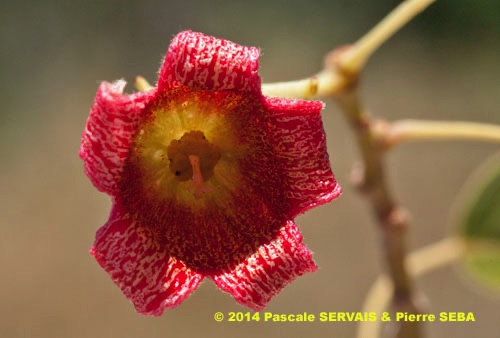
Brachychiton acerifolius F.Muell.
Fam. : Sterculiaceae
© Pascale SERVAIS & Pierre SEBA, 2018. Tilo Botanica: Flore de Tilos et du Dodécanèse / Flora of Tilos and of the Dodecanese
English translation by Brenda Bradbury, Howard Bradbury and Stéphane Léonard
Arbre monoïque, cultivé dans les jardins, originaire d’Australie. Son bois spongieux stocke de l’eau pour la survie dans un climat chaud et sec.
Feuilles alternes, simples, ovales à losangiques, entières ou à 3, 5 ou 7 lobes, de 12 à 25 cm de long, de 5 à 18 cm de large, terminées par une courte pointe, glabres, caduques ou semi-persistantes, longuement pétiolées. Stipules présentes mais caduques. Limbe à 1 veine centrale et à 2 ou 4 veines latérales partant de la base du limbe.
Fleurs à symétrie radiaire, entièrement rouge corail, uniformément rouges à l’intérieur, de 15 à 20 mm de diamètre, réunies en grappes ou en cymes de 12 à 25 cm de long. Périanthe à 5 tépales soudés, en cloche, à lobes recourbés vers l’extérieur, glabres ou à poils étoilés épars à l’extérieur. Ovaire supère.
Fruits, follicules brun foncé, glabres, de 8 à 12 cm de long, de 3,5 à 4 cm de large, renfermant plusieurs graines de 10 à 12 mm de long, de 5 à 7 mm de large, jaunes, non terminées par une petite pointe entourée d’un cercle plus foncé.
___________________________
Tree monoecious, cultivated in gardens, native to Australia. Its soft spongy wood stores water for survival in a hot and dry climate.
Leaves alternate, simple, ovate to diamond-shaped, entire or with 3, 5 or 7 lobes, from 12 to 25 cm long, from 5 to 18 cm across, finished by a short point, glabrous, deciduous or semi-persistent, lengthily petiolate. Stipules present but deciduous. Blade with 1 midrib and 2 or 4 lateral veins proceeding from the base of the blade.
Flowers radially symmetrical, entirely coral-red, uniformly red inside, from 15 to 20 mm in diameter, joined together in racemes or cymes from 12 to 25 cm long. Perianth with 5 fused tepals, bell-shaped, with lobes curved towards outside, glabrous or with scattered stellate hairs outside. Ovary superior.
Fruits, dark brown, glabrous follicles, from 8 to 12 cm long, from 3.5 to 4 cm across, containing several seeds from 10 to 12 mm long, from 5 to 7 mm across, yellow, not finished by a small point surrounded by a darker circle.
Descripteurs / Identifying features
1
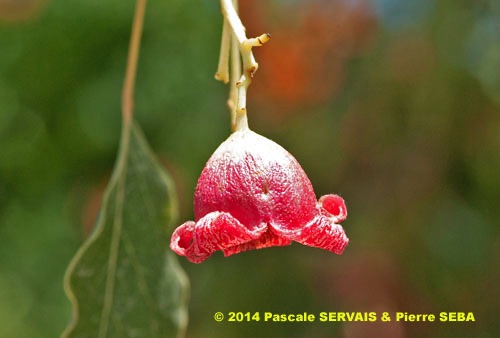
2
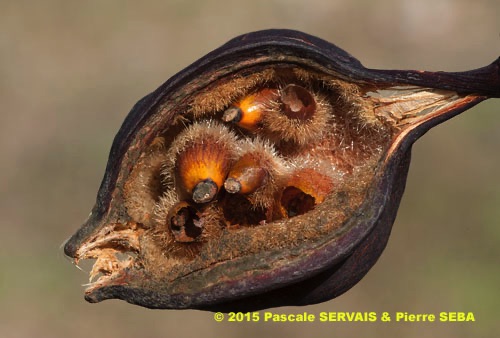
3
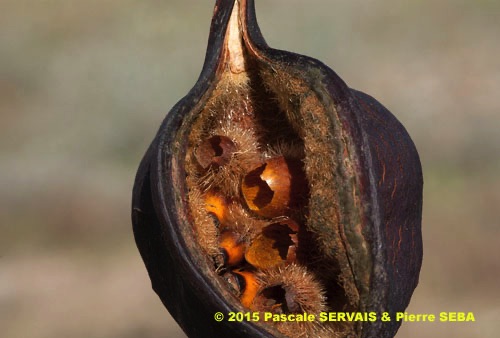
4
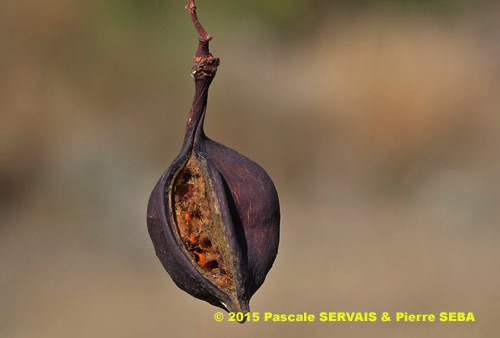
5
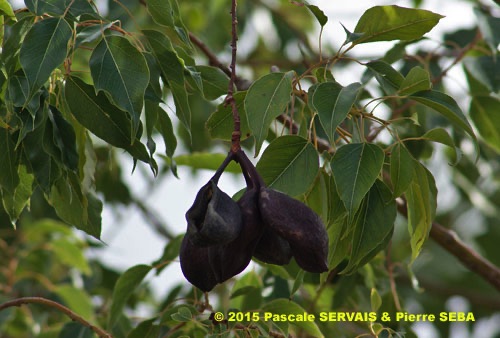
6
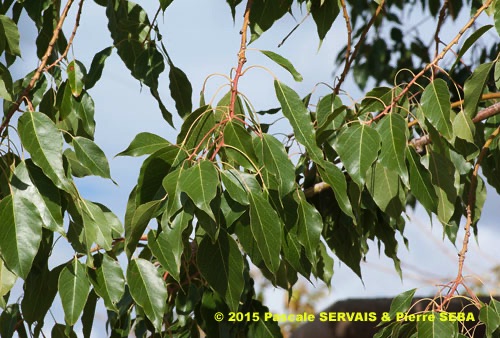
7
Étymologie / Etymology :
Brachychiton : emprunt du grec ancien βραχύς, -εῖα, -ύ (adj.) = court
+ χιτών, -ῶνος (nom) = le vêtement, la tunique. Le nom grec
désigne un vêtement court, en référence aux poils entourant,
comme un manteau, la graine dans le fruit.
Acerifolius : adjectif créé par les botanistes [ < acer, -eris (nom)
= l’érable + folium, -i (nom) = la feuille ] = à feuilles d’érable, qui a
des feuilles semblables à celles de l’érable.
Brachychiton : borrowed from Classical Greek βραχύς, -εῖα, -ύ (adj)
= short + χιτών, -ῶνος (noun) = clothing, tunic. The Greek name
means a short dress, referring to the bristles surrounding, as a coat,
the seed in the fruit.
Acerifolius : adjective created by botanists [ < acer, -eris (noun)
= maple + folium, -i (noun) = leaf ] = with maple-like leaves,
which has leaves similar to those of the maple.
Synonyme / Synonym :
Sterculia acerifolia A.Cunn. ex G.Don
Noms vernaculaires / Common names :
Noms français / French names :
Arbre de feu — Brachychiton à feuilles d’érable —
Flamme australienne — Sterculia à feuilles d’érable.
Noms grecs / Greek names :
Βραχυχιτόν — Βραχυχίτων.
Noms anglais / English names :
Australian flame tree — Flame bottletree — Flame durrajong —
Flame tree — Flametree — Illawara flame tree — Lacebark tree.
Habitat :
Jardins.
Gardens.
Île / Island :
Tilos.
Hauteur / Height range :
De 5 m à plus de 15 m.
From 5 m to 15 m and more.
Floraison / Flowering time :
De mai à juin.
From May to June.
Groupe / Classification :
Dicotylédones.
Dicotyledons.
Pérennité / Lifespan :
Vivace.
Perennial.
Description :
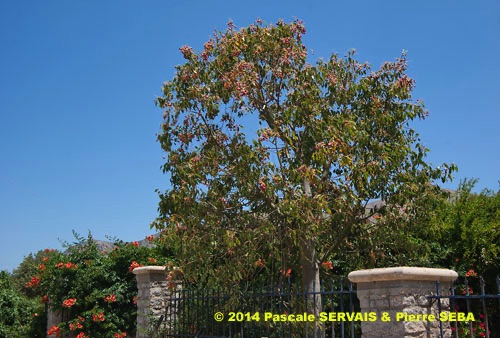
8
Clés dichotomiques et descripteurs distinctifs des 2 espèces / Dichotomous keys and distinctive identifying features of the 2 species
Photo 1 :
Localisation / Location : Tilos, Megalochorio, Erystos
Date : 31/05/2014
GPS : Lat. 36,43482° N / Long. 27,34933° E / Alt. 10 m
Type : Photographie numérique / Digital Photograph (10 mégapixels)
Photo 2 :
Localisation / Location : Tilos, Megalochorio, Erystos
Date : 31/05/2014
GPS : Lat. 36,43482° N / Long. 27,34933° E / Alt. 10 m
Type : Photographie numérique / Digital Photograph (10 mégapixels)
Photo 3 :
Localisation / Location : Tilos, Megalochorio, Erystos
Date : 15/11/2014
GPS : Lat. 36,43482° N / Long. 27,34933° E / Alt. 10 m
Type : Photographie numérique / Digital Photograph (10 mégapixels)
Photo 4 :
Localisation / Location : Tilos, Megalochorio, Erystos
Date : 15/11/2014
GPS : Lat. 36,43482° N / Long. 27,34933° E / Alt. 10 m
Type : Photographie numérique / Digital Photograph (10 mégapixels)
Photo 5 :
Localisation / Location : Tilos, Megalochorio, Erystos
Date : 15/11/2014
GPS : Lat. 36,43482° N / Long. 27,34933° E / Alt. 10 m
Type : Photographie numérique / Digital Photograph (10 mégapixels)
Photo 6 :
Localisation / Location : Tilos, Megalochorio, Erystos
Date : 15/11/2014
GPS : Lat. 36,43482° N / Long. 27,34933° E / Alt. 10 m
Type : Photographie numérique / Digital Photograph (10 mégapixels)
Photo 7 :
Localisation / Location : Tilos, Megalochorio, Erystos
Date : 15/11/2014
GPS : Lat. 36,43482° N / Long. 27,34933° E / Alt. 10 m
Type : Photographie numérique / Digital Photograph (10 mégapixels)
Photo 8 :
Localisation / Location : Tilos, Megalochorio, Erystos
Date : 31/05/2014
GPS : Lat. 36,43482° N / Long. 27,34933° E / Alt. 10 m
Type : Photographie numérique / Digital Photograph (10 mégapixels)

Google Maps
Google Maps
Google Maps
Google Maps
Google Maps
Google Maps
Google Maps
Google Maps